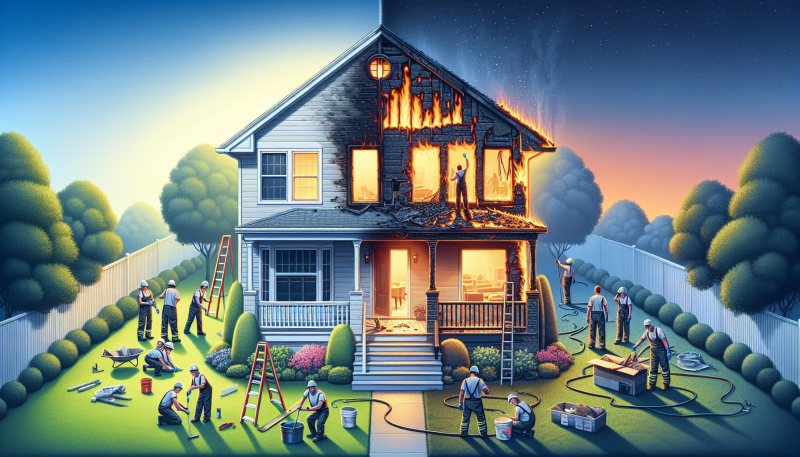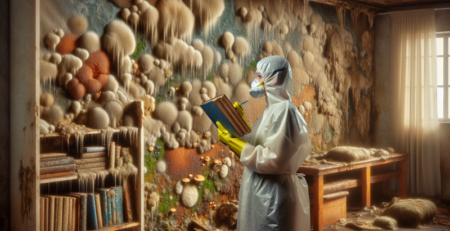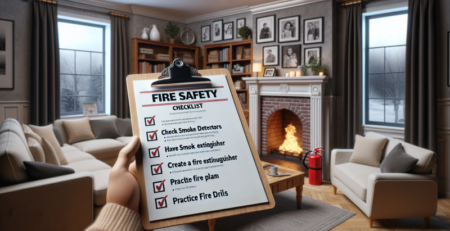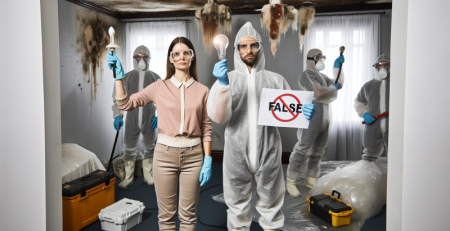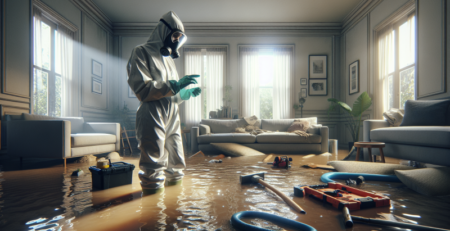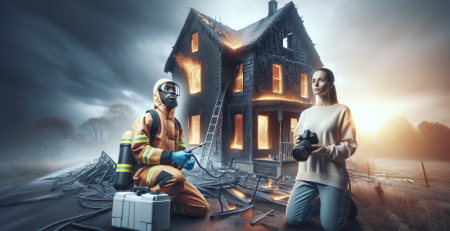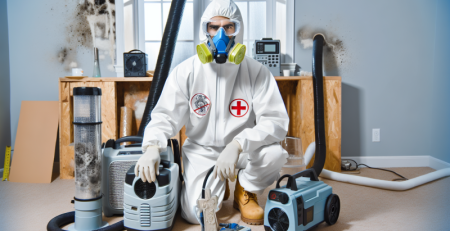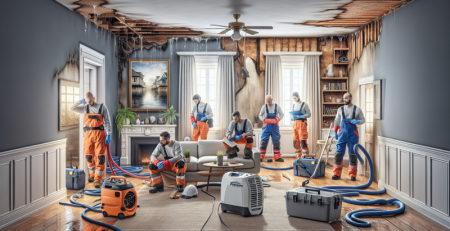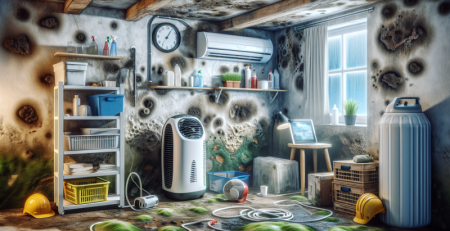Fire Damage: Restoring Your Home’s Value
Experiencing fire damage in your home can be overwhelming and devastating. Not only does it disrupt your life, but it also significantly impacts your property’s value. At Kraus Restoration, NJ’s leaders in water, mold, and fire damage restoration, we understand the urgency and complexity of restoring your home to its former glory. Our IICRC certified experts are available 24/7, providing rapid response to Central and Northern NJ residents. In this blog, we will guide you through the essential steps to restore your home’s value after fire damage, ensuring a safe and efficient recovery process. Whether you’re dealing with smoke damage, structural issues, or soot removal, our comprehensive fire damage restoration services are designed to address all your needs. Call us at (973) 886-2021 for immediate assistance and let us help you reclaim your home.
Assessing the Extent of Fire Damage
Assessing the extent of fire damage is a critical first step in the process of restoring your home’s value after a devastating fire. Understanding the full scope of the damage allows homeowners and restoration professionals to develop a comprehensive plan for repairs and rebuilding. This assessment involves a detailed inspection of the property, identifying both visible and hidden damage, and determining the necessary steps to restore the home to its pre-fire condition.
Initial Inspection and Safety Assessment
The first step in assessing fire damage is conducting a thorough initial inspection. This involves evaluating the structural integrity of the building to ensure it is safe to enter. Fire can weaken walls, floors, and roofs, making them susceptible to collapse. Therefore, it is crucial to have a professional inspector assess the safety of the structure before anyone enters the premises.
"Safety is the top priority when dealing with fire-damaged properties. Always ensure that the building is structurally sound before beginning any restoration work."
Identifying Visible Damage
Once the property is deemed safe, the next step is to identify visible damage. This includes:
- Charred walls, ceilings, and floors
- Burnt furniture and personal belongings
- Damaged electrical systems and appliances
- Broken windows and doors
Visible damage is often the most obvious and can give a clear indication of the fire’s intensity and the areas most affected. However, it is essential to remember that fire damage is not always confined to what is immediately visible.
Detecting Hidden Damage
Hidden damage can be just as detrimental as visible damage, if not more so. Smoke and soot can penetrate walls, insulation, and HVAC systems, causing long-term issues if not properly addressed. Additionally, water used to extinguish the fire can lead to mold growth and structural weakening.
Professional restoration companies, like Kraus Restoration, utilize advanced techniques and equipment to detect hidden damage. Thermal imaging cameras, moisture meters, and air quality monitors are some of the tools used to identify areas that require attention.
Evaluating Structural Damage
Structural damage assessment is a crucial part of the fire damage evaluation process. This involves checking the foundation, load-bearing walls, beams, and roof for any signs of compromise. Structural engineers may be called in to provide a detailed analysis and recommend necessary repairs or reinforcements.
Assessing Smoke and Soot Damage
Smoke and soot can cause extensive damage to a home, even in areas not directly affected by the fire. These particles can corrode metal, discolor surfaces, and leave behind a persistent odor. It is essential to assess the extent of smoke and soot damage to determine the best cleaning and deodorizing methods.
Estimating Repair Costs
After a comprehensive assessment, the next step is to estimate the repair costs. This includes the cost of materials, labor, and any specialized services required, such as mold remediation or structural repairs. Having a detailed estimate helps homeowners understand the financial implications and work with their insurance companies to cover the expenses.
Working with Insurance Companies
Navigating the insurance claims process can be challenging. It is beneficial to work with a restoration company that has experience dealing with insurance companies. They can help document the damage, provide detailed reports, and negotiate with the insurance adjuster to ensure you receive fair compensation.
Developing a Restoration Plan
Once the extent of the damage is fully assessed, a detailed restoration plan can be developed. This plan outlines the steps needed to restore the home, including:
- Debris removal and cleanup
- Structural repairs and rebuilding
- Smoke and soot cleaning
- Water damage restoration
- Final inspections and approvals
For more information on the restoration process, visit our fire cleanup services page.
Conclusion
Assessing the extent of fire damage is a vital step in restoring your home’s value. By conducting a thorough inspection, identifying both visible and hidden damage, and working with professionals, homeowners can ensure their property is restored to its pre-fire condition. For expert assistance and comprehensive restoration services, contact Kraus Restoration today. Visit our contact page to get in touch with our team.
For more insights into our work, explore our residential design projects and see how we have helped other homeowners restore their properties.
Immediate Steps to Take After a Fire
Experiencing a fire in your home can be a traumatic and overwhelming event. The aftermath leaves homeowners grappling with the emotional and physical toll of the damage. However, taking immediate and strategic steps can significantly influence the restoration process and help in restoring your home’s value. Here’s a comprehensive guide on what to do right after a fire to ensure a smoother recovery.
First and foremost, ensure the safety of all occupants. Once the fire is extinguished and it’s safe to re-enter the property, conduct a headcount to make sure everyone is accounted for. If anyone is missing or injured, contact emergency services immediately. Safety should always be your top priority.
Next, contact your insurance company as soon as possible. Inform them about the fire and start the claims process. Document the damage by taking photographs and making a detailed list of all affected items. This documentation will be crucial for your insurance claim. Be sure to keep all receipts for any expenses incurred due to the fire, such as temporary housing or emergency repairs.
Once the immediate safety and insurance steps are taken, it’s time to focus on securing your property. If the fire has compromised the structure of your home, you may need to board up windows and doors or put up a temporary fence to prevent unauthorized access. This not only protects your property from further damage but also ensures the safety of others.
After securing your home, it’s essential to address any water damage caused by firefighting efforts. Water can cause significant harm to your property and lead to mold growth if not dealt with promptly. Consider hiring a professional water cleanup service to thoroughly dry out your home and prevent further issues. For more information on water damage restoration, visit our water cleanup services page.
Next, assess the extent of the fire damage. This includes structural damage, soot, and smoke damage. It’s advisable to hire a professional fire damage restoration company to evaluate and handle the cleanup. Professionals have the expertise and equipment to safely remove soot and smoke residues, which can be harmful if not properly managed. For specialized fire damage restoration services, check out our fire cleanup services.
In addition to fire and water damage, mold can become a significant issue if not addressed promptly. Mold thrives in damp environments, and the water used to extinguish the fire can create the perfect conditions for mold growth. Mold can cause health problems and further damage your property. To prevent this, consider professional mold cleanup services. Learn more about our mold remediation solutions on our mold cleanup services page.
While dealing with the immediate aftermath of a fire, it’s also important to think about the long-term restoration of your home. This includes repairing structural damage, replacing damaged items, and restoring the aesthetic value of your property. Working with a reputable restoration company can help you navigate this process efficiently. They can provide a comprehensive plan to restore your home to its pre-fire condition, ensuring that all aspects of the damage are addressed.
Finally, communication is key throughout this process. Keep in touch with your insurance company, restoration professionals, and any other relevant parties. Regular updates and clear communication can help ensure that the restoration process goes smoothly and that any issues are addressed promptly.
In conclusion, the immediate steps you take after a fire can significantly impact the restoration of your home’s value. Prioritize safety, document the damage, secure your property, address water and mold issues, and work with professionals to restore your home. For more information about our restoration services, visit our services page or contact us directly. Taking these steps can help you navigate the challenging aftermath of a fire and restore your home to its former glory.
Hiring Professional Fire Damage Restoration Services
When a fire ravages your home, the aftermath can be overwhelming. The damage extends beyond what the eye can see, affecting the structural integrity, air quality, and overall safety of your property. This is where professional fire damage restoration services come into play. Hiring experts in fire damage restoration is crucial for restoring your home’s value and ensuring it is safe for occupancy.
Professional fire damage restoration services offer a comprehensive approach to dealing with the aftermath of a fire. These experts are trained to handle everything from soot and smoke removal to structural repairs and odor elimination. One of the primary benefits of hiring professionals is their ability to assess the full extent of the damage. They use advanced tools and techniques to identify hidden damage that may not be immediately visible, such as compromised structural elements or lingering smoke particles that can affect indoor air quality.
Moreover, professional restoration services provide a systematic approach to cleaning and repairing your home. They begin with a thorough inspection to determine the scope of the damage. This is followed by immediate actions to prevent further damage, such as boarding up windows or covering damaged roofs. The next steps typically involve water removal and drying, especially if firefighting efforts have left your home waterlogged. This is crucial to prevent mold growth, which can further deteriorate your property and pose health risks. For more information on water damage restoration, you can visit our water cleanup services page.
Smoke and soot removal is another critical aspect of fire damage restoration. These residues can penetrate walls, furniture, and other porous materials, leaving behind unpleasant odors and potential health hazards. Professional restoration teams use specialized equipment and cleaning agents to remove soot and smoke from all affected surfaces. They also employ air scrubbers and dehumidifiers to improve air quality and eliminate lingering odors.
In addition to cleaning and repairing visible damage, professional fire damage restoration services also address structural repairs. Fires can weaken the structural integrity of your home, making it unsafe for occupancy. Restoration experts are trained to identify and repair structural damage, ensuring that your home is safe and stable. They work closely with engineers and contractors to restore your home to its pre-fire condition, or even better.
Another significant advantage of hiring professional fire damage restoration services is their ability to handle the insurance claims process. Dealing with insurance companies can be a daunting task, especially when you are already coping with the emotional and physical toll of a fire. Restoration professionals can document the damage, provide detailed estimates, and communicate directly with your insurance company to ensure you receive the compensation you deserve. This can significantly reduce the stress and hassle associated with the claims process.
Furthermore, professional restoration services offer peace of mind. Knowing that experts are handling the restoration process allows you to focus on your family and personal well-being. These professionals are equipped with the knowledge, experience, and resources to restore your home efficiently and effectively. They adhere to industry standards and regulations, ensuring that the restoration process is conducted safely and thoroughly.
In conclusion, hiring professional fire damage restoration services is essential for restoring your home’s value and ensuring it is safe for occupancy. These experts provide a comprehensive approach to dealing with fire damage, from initial assessment and immediate actions to cleaning, repairs, and insurance claims assistance. By entrusting your home to professionals, you can rest assured that the restoration process will be handled efficiently and effectively, allowing you to focus on rebuilding your life. For more information about our services, please visit our fire cleanup services page or contact us directly.
Cleaning and Deodorizing Your Home
After a fire, one of the most challenging tasks homeowners face is cleaning and deodorizing their property. The aftermath of a fire leaves behind not only visible damage but also pervasive odors and potentially harmful residues. Addressing these issues promptly and effectively is crucial for restoring your home’s value and ensuring a safe living environment.
Initial Assessment and Safety Measures
Before diving into the cleaning process, it’s essential to conduct a thorough assessment of the damage. This step helps in identifying the areas that need immediate attention and those that can be addressed later. Always prioritize safety by wearing protective gear such as gloves, masks, and goggles. Fire-damaged areas can contain hazardous materials like soot, ash, and chemicals that pose health risks.
Removing Soot and Ash
Soot and ash are common byproducts of a fire and can settle on various surfaces, including walls, ceilings, and furniture. These residues are not only unsightly but can also cause respiratory issues if not properly removed. Start by vacuuming loose soot and ash using a vacuum cleaner with a HEPA filter. Avoid using regular vacuums as they can spread fine particles into the air.
For stubborn soot stains, use a dry sponge or a specialized soot sponge. These sponges are designed to lift soot without smearing it further. Gently wipe the affected areas, working from top to bottom to prevent recontamination. For more extensive cleaning, consider hiring professional fire cleanup services. Learn more about our fire cleanup services to ensure a thorough and safe cleaning process.
Deep Cleaning Surfaces
Once the loose soot and ash are removed, it’s time to deep clean the surfaces. Use a mixture of warm water and mild detergent to scrub walls, floors, and other hard surfaces. For porous materials like wood and upholstery, a more delicate approach is needed. Consider using a specialized cleaner designed for these materials to avoid damage.
In some cases, smoke and soot can penetrate deep into the materials, making it difficult to remove the residues completely. Professional cleaning services have the tools and expertise to handle such situations effectively. They use advanced techniques like thermal fogging and ozone treatment to neutralize odors and remove contaminants.
Deodorizing Your Home
One of the most persistent challenges after a fire is eliminating the lingering smoke odor. Smoke particles can embed themselves in fabrics, carpets, and even the walls, making it difficult to get rid of the smell. Start by airing out your home as much as possible. Open windows and use fans to promote ventilation.
For a more thorough deodorization, consider using activated charcoal or baking soda. These substances are excellent at absorbing odors. Place bowls of activated charcoal or baking soda around the affected areas and leave them for several days. You can also sprinkle baking soda on carpets and upholstery, let it sit for a few hours, and then vacuum it up.
Professional deodorization services can be highly effective in tackling stubborn odors. Techniques like ozone treatment and thermal fogging can reach areas that regular cleaning methods cannot. These treatments neutralize odor-causing particles, leaving your home smelling fresh and clean.
Addressing Water Damage
Firefighting efforts often involve large amounts of water, which can lead to water damage in addition to fire damage. It’s crucial to address water damage promptly to prevent mold growth and further structural issues. Start by removing any standing water and drying out the affected areas. Use dehumidifiers and fans to speed up the drying process.
For extensive water damage, professional water cleanup services are recommended. They have the equipment and expertise to handle large-scale water removal and drying. Learn more about our water cleanup services to ensure your home is thoroughly dried and safe from mold growth.
Final Steps and Professional Help
Restoring your home after a fire is a complex process that often requires professional assistance. From cleaning and deodorizing to addressing water damage and structural repairs, each step is crucial for restoring your home’s value and ensuring a safe living environment. At Kraus Restoration, we offer comprehensive services to help you through every stage of the restoration process. Visit our about page to learn more about our expertise and commitment to quality.
By following these steps and seeking professional help when needed, you can effectively clean and deodorize your home, making it a safe and comfortable place to live once again.
Repairing Structural Damage
When a fire ravages your home, the aftermath can be overwhelming. Beyond the visible damage to furniture and personal belongings, the structural integrity of your home may be compromised. Repairing structural damage is a critical step in restoring your home’s value and ensuring it is safe for occupancy. This process involves a thorough assessment, meticulous planning, and expert execution to bring your home back to its former glory.
The first step in repairing structural damage is a comprehensive assessment by a qualified professional. This assessment will identify the extent of the damage to the foundation, walls, roof, and other critical components of your home. Fire can weaken these structures, making them susceptible to collapse or further damage if not properly addressed. During the assessment, experts will look for signs of charring, warping, and other indicators of compromised integrity. This detailed evaluation is essential for developing a targeted repair plan.
Once the assessment is complete, the next phase involves planning the repairs. This stage requires collaboration between structural engineers, contractors, and restoration specialists to ensure all aspects of the damage are addressed. The repair plan will outline the necessary steps to reinforce or replace damaged components, ensuring the structural stability of your home. This may include tasks such as replacing damaged beams, reinforcing weakened walls, and repairing or replacing the roof. The goal is to restore the structural integrity of your home to its pre-fire condition or better.
Executing the repair plan requires skilled professionals with experience in fire damage restoration. These experts will use specialized techniques and materials to ensure the repairs are durable and meet all safety standards. For instance, fire-damaged wood may need to be replaced with new, treated lumber that is resistant to future fire damage. Similarly, damaged concrete or masonry may require reinforcement with steel or other materials to restore its strength. Throughout the repair process, continuous inspections are conducted to ensure each step is completed correctly and safely.
In addition to repairing the structural damage, it is also important to address any secondary issues that may arise from the fire. For example, water used to extinguish the fire can lead to mold growth, which can further compromise the structural integrity of your home. It is crucial to conduct a thorough mold cleanup to prevent these issues from escalating. Similarly, smoke and soot can penetrate building materials, causing lingering odors and potential health hazards. Specialized cleaning and deodorizing techniques are necessary to remove these contaminants and restore a healthy living environment.
Throughout the entire process, communication with your restoration team is key. Regular updates and consultations will ensure you are informed about the progress and any potential challenges that may arise. This collaborative approach helps to address any concerns promptly and ensures the project stays on track.
Repairing structural damage after a fire is a complex and demanding task, but it is essential for restoring your home’s value and ensuring it is safe for you and your family. By working with experienced professionals and following a detailed repair plan, you can rebuild your home with confidence. If you need expert assistance with fire damage restoration, don’t hesitate to contact our team at Kraus Restoration. We are dedicated to helping you through every step of the process, from initial assessment to final repairs, ensuring your home is restored to its full potential.
For more information about our services and past projects, visit our about page and explore our projects to see how we have helped other homeowners recover from fire damage.
Restoring Personal Belongings
When a fire ravages your home, the damage extends beyond the structure itself. Personal belongings, often holding sentimental value and irreplaceable memories, can also suffer significant harm. Restoring these items is a crucial step in the overall recovery process, helping to bring a sense of normalcy and comfort back into your life. This guide will walk you through the essential steps and considerations for restoring personal belongings after fire damage, ensuring that you can salvage as much as possible and restore your home’s value.
Assessing the Damage
The first step in restoring personal belongings is to assess the extent of the damage. This involves a thorough inspection of all items affected by the fire, smoke, and soot. It’s important to categorize belongings into three groups: salvageable, unsalvageable, and those requiring professional restoration. Items like clothing, furniture, and electronics may appear to be beyond repair but can often be restored with the right techniques and expertise.
Cleaning and Deodorizing
Smoke and soot can penetrate deeply into fabrics, wood, and other materials, leaving behind a persistent odor and potential health hazards. Cleaning and deodorizing are critical steps in the restoration process. For fabrics, specialized cleaning solutions and techniques, such as ozone treatment, can effectively remove smoke odors. Hard surfaces like wood and metal may require thorough scrubbing and the application of sealants to prevent further damage.
Professional Restoration Services
For items that are particularly valuable or heavily damaged, professional restoration services are often the best option. Experts in fire damage restoration have access to advanced equipment and techniques that can significantly improve the chances of salvaging your belongings. For instance, ultrasonic cleaning can be used for delicate items like jewelry and electronics, while freeze-drying can restore important documents and photographs.
Documenting the Process
As you go through the restoration process, it’s essential to document everything. Take photographs of damaged items before and after restoration, and keep detailed records of all cleaning and repair efforts. This documentation will be invaluable for insurance claims and can help ensure you receive the compensation you deserve.
Preventing Future Damage
Once your belongings have been restored, it’s important to take steps to prevent future damage. This includes installing smoke detectors, fire extinguishers, and other fire safety equipment in your home. Regular maintenance and inspections can also help identify potential fire hazards before they become a problem.
Working with Professionals
Restoring personal belongings after a fire is a complex and often overwhelming task. Working with professionals can make the process more manageable and increase the likelihood of successful restoration. At Kraus Restoration, we offer comprehensive fire cleanup services designed to restore your home and belongings to their pre-fire condition. Our team of experts is trained in the latest restoration techniques and uses state-of-the-art equipment to ensure the best possible results.
Conclusion
Restoring personal belongings after fire damage is a challenging but essential part of the recovery process. By assessing the damage, cleaning and deodorizing, utilizing professional restoration services, documenting the process, and taking steps to prevent future damage, you can salvage cherished items and restore your home’s value. For more information on our services and how we can help you, please visit our about page or contact us directly.
Preventing Future Fire Hazards
When it comes to restoring your home’s value after fire damage, preventing future fire hazards is a crucial step. Not only does it ensure the safety of your family and property, but it also helps maintain the integrity and value of your home. Here are some essential strategies to prevent future fire hazards and protect your investment.
Install and Maintain Smoke Detectors
One of the simplest yet most effective ways to prevent fire hazards is by installing smoke detectors throughout your home. Make sure to place them in key areas such as the kitchen, bedrooms, and hallways. Regularly test the detectors to ensure they are functioning correctly and replace the batteries at least once a year. For added safety, consider interconnected smoke alarms that will alert you throughout the house if one detector senses smoke.
Regular Electrical Inspections
Faulty wiring is a common cause of house fires. To mitigate this risk, schedule regular electrical inspections by a licensed electrician. They can identify and repair any potential issues such as outdated wiring, overloaded circuits, or faulty outlets. If you live in an older home, it may be worth investing in an electrical system upgrade to meet current safety standards.
Safe Cooking Practices
The kitchen is a hotspot for potential fire hazards. Always stay in the kitchen while cooking, especially when using high heat. Keep flammable items like dish towels, paper towels, and wooden utensils away from the stove. Additionally, ensure that your kitchen is equipped with a fire extinguisher and that everyone in the household knows how to use it.
Proper Storage of Flammable Materials
Many common household items are flammable and should be stored properly to prevent fire hazards. Keep flammable liquids such as gasoline, paint thinners, and cleaning supplies in their original containers and store them in a cool, well-ventilated area away from heat sources. Make sure to follow the manufacturer’s instructions for storage and disposal.
Regular Maintenance of Heating Systems
Heating systems, including furnaces, fireplaces, and space heaters, should be regularly maintained to prevent fire hazards. Have your furnace inspected and cleaned annually by a professional. If you use a fireplace, ensure the chimney is cleaned and inspected regularly to prevent the buildup of creosote, which can ignite and cause a chimney fire. Always use a screen to prevent sparks from escaping the fireplace.
Create a Fire Escape Plan
In the event of a fire, having a well-thought-out escape plan can save lives. Develop a fire escape plan that includes at least two exits from every room and a designated meeting place outside the home. Practice the plan regularly with all household members to ensure everyone knows what to do in case of a fire.
Invest in Fire-Resistant Building Materials
When restoring your home after fire damage, consider using fire-resistant building materials. Options such as fire-rated drywall, fire-resistant insulation, and non-combustible roofing materials can significantly reduce the risk of future fires. These materials not only enhance the safety of your home but also add to its overall value.
Professional Fire Cleanup Services
After experiencing fire damage, it’s essential to hire professional fire cleanup services to ensure your home is thoroughly restored and safe for occupancy. Professionals can identify and address hidden damage, remove soot and smoke residues, and deodorize your home. For comprehensive fire cleanup services, visit Kraus Restoration.
Stay Informed and Vigilant
Staying informed about fire safety and remaining vigilant can go a long way in preventing future fire hazards. Regularly review fire safety guidelines and educate your family about fire prevention measures. Stay updated on the latest fire safety technologies and consider integrating them into your home.
By taking these proactive steps, you can significantly reduce the risk of future fire hazards and protect your home’s value. For more information on how to safeguard your home and restore its value after fire damage, explore the range of services offered by Kraus Restoration. If you have any questions or need professional assistance, don’t hesitate to contact us. Your safety and peace of mind are our top priorities.
Conclusion: Restoring Your Home’s Value After Fire Damage
In the aftermath of a fire, the journey to restoring your home’s value can seem daunting. However, with a clear plan, the right resources, and professional assistance, it is entirely possible to bring your home back to its former glory—or even enhance its value. Start by assessing the damage comprehensively, prioritize safety, and engage with experienced restoration professionals who can guide you through the process. Remember, timely action is crucial to prevent further deterioration and to begin the healing process for your home and your peace of mind.
Investing in quality repairs, thorough cleaning, and thoughtful renovations not only restores the physical structure but also rejuvenates the emotional essence of your home. By taking these steps, you not only reclaim your property’s value but also create a renewed space that offers comfort, security, and a fresh start for you and your family. Fire damage is a challenging hurdle, but with resilience and the right approach, your home can emerge stronger and more valuable than ever.
